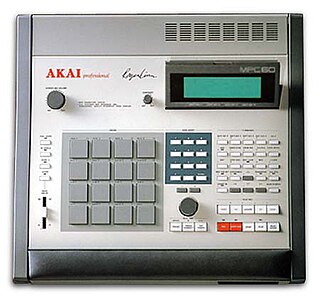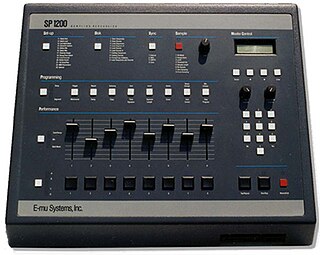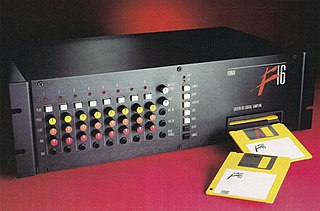
A drum machine is an electronic musical instrument that creates percussion sounds, drum beats, and patterns. Drum machines may imitate drum kits or other percussion instruments, or produce unique sounds, such as synthesized electronic tones. Most modern drum machines allow users to program their own rhythms and beats. Drum machines may create sounds using analog synthesis or play prerecorded samples. Some drum machines have buttons or pads that allow the performer to play drum sounds "live", either on top of a programmed drum beat or as a standalone performance. Drum machines have a range of capabilities, which go from playing a short beat pattern in a loop, to being able to program or record complex song arrangements with changes of meter and style.

Digital music technology encompasses digital instruments, computers, electronic effects units, software, or digital audio equipment by a performer, composer, sound engineer, DJ, or record producer to produce, perform or record music. The term refers to electronic devices, instruments, computer hardware, and software used in performance, playback, recording, composition, mixing, analysis, and editing of music.

A groovebox is a self-contained electronic or digital musical instrument for the production of live, loop-based electronic music with a high degree of user control facilitating improvisation. The term "Groovebox" was originally used by Roland Corporation to refer to its MC-303, released in 1996. The term has since entered general use, and dates back to the Movement Computer Systems Drum Computer in 1981.
Akai was a Japanese consumer electronics brand. The company, Akai Electric Company Ltd, was founded in 1946 in Tokyo, Japan, and defunct in 2002. Grande Holdings in Hong Kong took over Akai's Brand, now it is distributing various electronics products such as LED TV, washing machines, air conditioners and smart phones, collaborated with other electronics companies. On the other hand, inMusic Brands in United States also took over Akai's Brand. It began Akai Professional brand, and is distributing high-end audio electronics products.
A music workstation is an electronic musical instrument providing the facilities of:

It is a drum pad/ recorder for hip-hop and other genre of music. A sampler is an electronic or digital musical instrument which uses sound recordings of real instrument sounds, excerpts from recorded songs or found sounds. The samples are loaded or recorded by the user or by a manufacturer. These sounds are then played back by means of the sampler program itself, a MIDI keyboard, sequencer or another triggering device to perform or compose music. Because these samples are usually stored in digital memory, the information can be quickly accessed. A single sample may often be pitch-shifted to different pitches to produce musical scales and chords.

The Akai MPC is a series of music workstations produced by Akai from 1988 onwards. The MPC combines sampling and sequencing functions.

Roger Linn is an American designer of electronic musical instruments and equipment. He is the designer of the LM-1, the first drum machine to use samples, and the MPC sampler, which had a major influence on the development of hip hop. Roger Linn is also a member of the Dead Presidents Society, a group of innovators in the field of electronic music.

Hip hop production is the creation of hip hop music in a recording studio. While the term encompasses all aspects of hip hop music creation, including recording the rapping of an MC, a turntablist or DJ providing a beat, playing samples and "scratching" using record players and the creation of a rhythmic backing track, using a drum machine or sequencer, it is most commonly used to refer to recording the instrumental, non-lyrical and non-vocal aspects of hip hop.

E-mu SP-1200 is a sampler that was released in August 1987 by E-mu Systems.

The LinnDrum is a drum machine manufactured by Linn Electronics between 1982 and 1985. About 5,000 units were sold.

An electronic drum module is an electronic or digital music device in an electronic drum kit that serves as the central processing unit and sound module. The drum module creates or produces the drum kit sounds or other sounds selected by the drummer. By itself, a drum module cannot play or sound drum beats. It only produces drum sounds when a performer strikes electronic drum pads or acoustic drum kit instruments that have electronic "triggers" attached to them. When the electronic drum pads or trigger-equipped instruments are struck, this sends a signal to the drum module, which produces the corresponding electronic drum sound. Even when drum pads and/or triggers are connected to a drum module, the drum module by itself does not make any audible sound. Like other electronic instruments such as the synthesizer, the drum module only outputs an electronic signal. The performer can hear this signal by connecting headphones to the drum module or by plugging the drum module into an amplifier and loudspeaker or PA system for audible practice or live performances. The drum module's output signal can also be patched into an audio console for concerts or sound recording. The nomenclature varies. For example, electronic drum modules are called "percussion sound modules" in the case of Roland Corporation, or sometimes simply modules. A common colloquial term for this device is drum brain..
The Akai S1000 is a 16-bit, 44.1 kHz professional stereo digital sampler, released by Akai in 1988. The S1000 was among the first professional-quality 16-bit stereo samplers. Its abilities to splice, crossfade, trim, and loop sound in 16-bit CD quality made it popular among producers in the late 80s through to the mid 90s. The S1000 used 24-bit internal processing, had digital filters and an effects send and return, and came with 2MB of RAM.

In music, sampling is the reuse of a portion of a sound recording in another recording. Samples may comprise elements such as rhythm, melody, speech, sounds, or entire bars of music, and may be layered, equalized, sped up or slowed down, repitched, looped, or otherwise manipulated. They are usually integrated using hardware (samplers) or software such as digital audio workstations.

The Linn 9000 is an electronic musical instrument manufactured by Linn Electronics as the successor to the LinnDrum. It was introduced in 1984 at a list price of $5,000, and about 1100 units were produced.
The LinnSequencer is a rack-mount 32-track hardware MIDI sequencer manufactured by Linn Electronics and released in 1985 at a list price of US $1,250. An optional Remote Control was available. Like the LinnDrum Midistudio, the LinnSequencer used the same flawed operating system used in the ill-fated Linn 9000, released in 1984. As a result, both machines earned a reputation for being notoriously unreliable. In addition, the optional LinnSequencer SMPTE feature could not be deployed due to flawed circuit design. The last LinnSequencer operating system released by Linn Electronics was version 5.17.

The Forat F16 is the first 16 bit digital sampler optimized for use as a "drum brain" or electronic drum module. It dynamically responds to trigger inputs from MIDI and/or audio signals. With a response time of 0.1 milliseconds, the F16 is the fastest audio triggering digital sampler ever sold. It was manufactured by Forat Music and Electronics, introduced in 1987 at a list price of $5200 and was discontinued in 1994. An optional Remote Control and SCSI capability was available for $1385.

The Forat F9000 is a software- and hardware-upgraded version of the ill-fated Linn 9000, an integrated digital sampling drum machine and hardware MIDI sequencer manufactured by Linn Electronics and released in 1984 at a list price of $5,000.

The LinnDrum Midistudio was going to be an electronic musical instrument produced by Linn Electronics as the successor to the ill-fated Linn 9000, which was an integrated digital sampling drum machine and MIDI sequencer. The Midistudio is essentially a rack-mount version of the Linn 9000 with some improvements. It was revealed at the 1986 Winter NAMM Show in January for a list price of $5,990. However, it never went into production because Linn Electronics went out of business in February 1986.



















